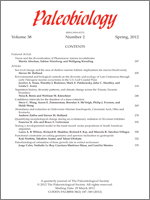A key question in studies of mass extinctions is whether the extinction was a sudden or gradual event. This question may be addressed by examining the locations of fossil occurrences in a stratigraphic section. However, the fossil record can be consistent with both sudden and gradual extinctions. Rather than being limited to rejecting or not rejecting a particular scenario, ideally we should estimate the range of extinction scenarios that is consistent with the fossil record. In other words, rather than testing the simplified distinction of “sudden versus gradual,” we should be asking, “How gradual?”
In this paper we answer the question “How gradual could the extinction have been?” by developing a confidence interval for the duration of a mass extinction. We define the duration of the extinction as the time or stratigraphic thickness between the first and last taxon to go extinct, which we denote by Δ. For example, we would like to be able to say with 90% confidence that the extinction took place over a duration of 0.3 to 1.1 million years, or 24 to 57 meters of stratigraphic thickness. Our method does not deny the possibility of a truly simultaneous extinction; rather, in this framework, a simultaneous extinction is one whose value of Δ is equal to zero years or meters.
We present an algorithm to derive such estimates and show that it produces valid confidence intervals. We illustrate its use with data from Late Permian ostracodes from Meishan, China, and Late Cretaceous ammonites from Seymour Island, Antarctica.





